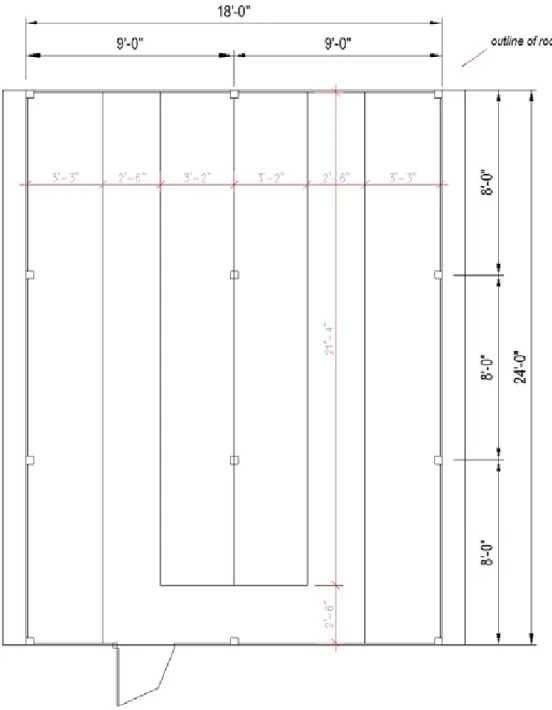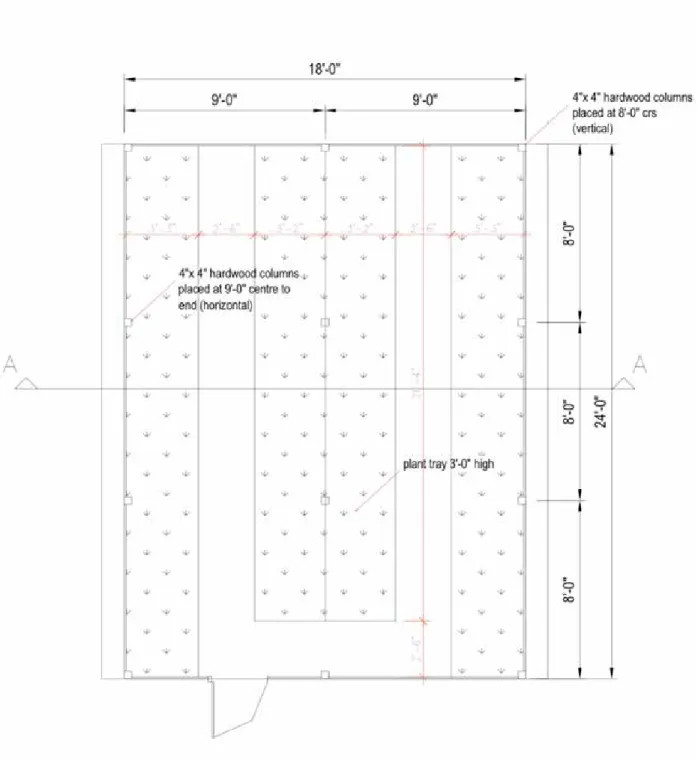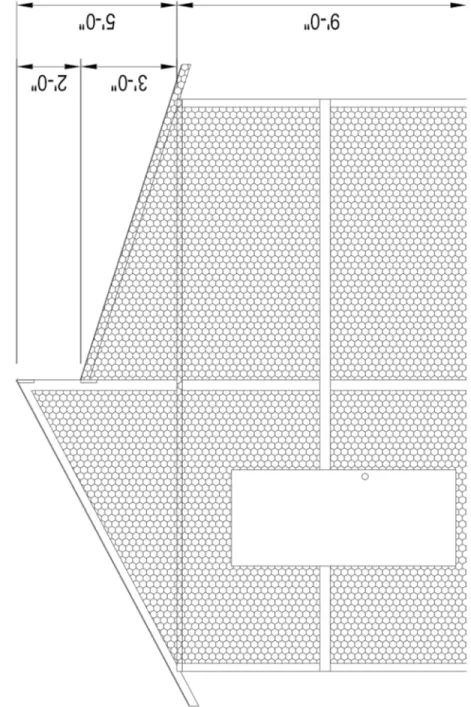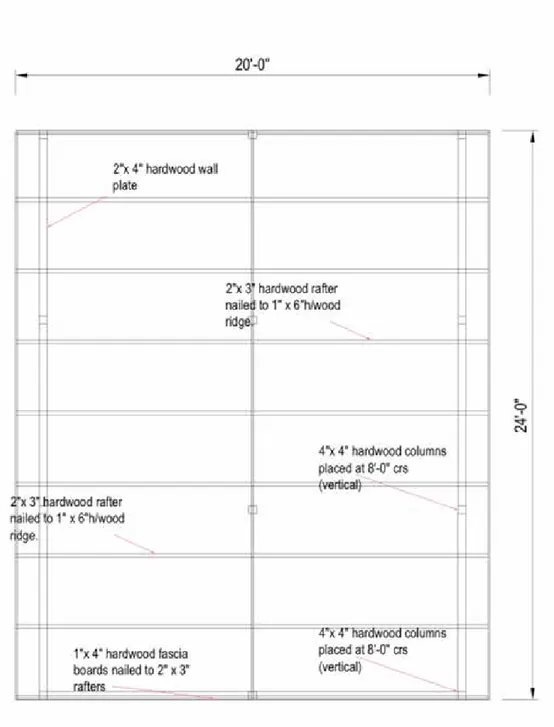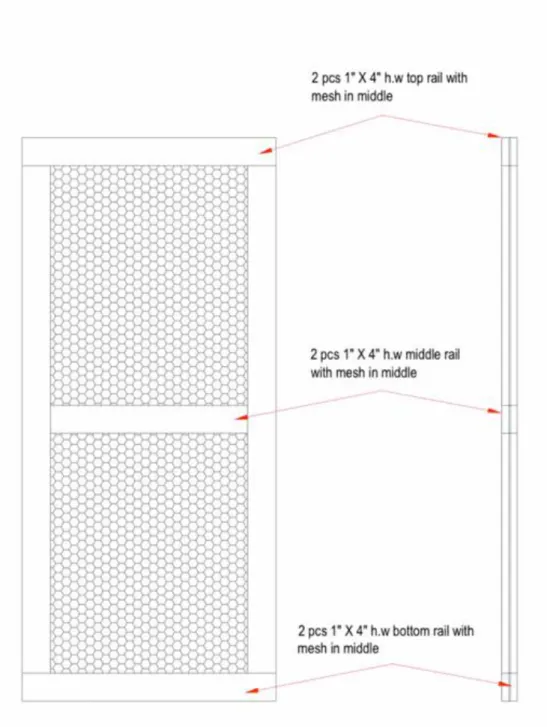Climate Smart Agriculture System
Shadehouse
P r o d u c t i o n
Manual
IICA Delegation in Guyana 18 Brickdam, Stabroek, Georgetown, Guyana
Tel: 592-226-8835 | 592-226-8347 iica.gy@iica.int | www.iica.int/guyana
Shadehouse
P r o d u c t i o n
Manual
Inter-American Institute for Cooperation on Agriculture
Inter-American Institute for Cooperation on Agriculture (IICA), 2017
Climate smart agriculture systems: shadehouse production manual by IICA is published under license Creative Commons
Attribution-ShareAlike 3.0 IGO (CC-BY-SA 3.0 IGO) (http://creativecommons.org/licenses/by-sa/3.0/igo/)
Based on a work at www.iica.int
IICA encourages the fair use of this document. Proper citation is requested. This publication is also available in electronic (PDF) format from the Institute’s Web site: http://www.iica.int
Editorial Coordination: Jermaine Joseph
Mechanical Editing: Wilmot Garnett, Siana Canzius, Maxine Parris-Aaron, Arnold De Mendonca, Elesha Jacobs
Layout: Karla Cruz Cover design: Karla Cruz Printed: IICA Print Shop
Climate smart agriculture systems: shadehouse production manual / Inter-American Institute for Cooperation on Agriculture. – Guyana : IICA, 2017.
44 p.; 21,6 cm X 28 cm.
ISBN: 978-92-9248-694-5
1. Climate change 2. Hydroponics 3. Greenhouses 4. Protected cultivation 5. Trickle irrigation 6. Innovation adoption I. IICA II. Title
AGRIS DEWEY F01 631.583
Georgetown, Guyana 2017
Foreword
“A green economy is necessary to ensure the sustainable
management of our natural resources.”
President David Arthur Granger, Cooperative Republic of Guyana
T
he core of IICA’s Medium-Term Plan (2014-2018) focuses on Agriculture: Opportunities for Development in the Americas. More specifically, Strategic objective 3 highlights the importance of improving agriculture’s capacity to mitigate and adapt to climate change and make better use of natural resources. Through the financial support of the IICA Resilience and Inclusion Flagship Projects, the IICA Delegation in Guyana was able to work with selected communities to impart proven protected agricultural production systems and practices, increasing rural income and food security.Over the years, hydroponics production has gained popularity with commercial scale-up operations, high schools, peri-urban settings and remote communities where fresh vegetables are for the most part non-existent. Practitioners of this production technique have been supported by our collaborative effort with the ministries of Agriculture and Education, Partners of the Americas and the FAO. Extensive work has been completed and results and best practices are being documented for dissemination to current and potential practitioners.
We are pleased to present this revised version of our Hydroponics Manual. It was prepared to serve as a guide to those who are interested in the technique, and to our users who are familiar with it. I also take this opportunity to thank the staff of the IICA Delegation in Guyana and the leaders and coordinators of the IICA Resilience and Inclusion Flagship Projects for their continued support.
Wilmot Garnett
Table of Contents
Foreword. . . iii
Background. . . vii
Introduction . . . ix
1. What is protected agriculture? . . . 1
2. What is drip irrigation? . . . 2
3. Types of protected agriculture structures . . . 3
4. What is hydroponics?. . . 5 Advantages of hydroponics . . . .5 Disadvantages of hydroponics . . . .6 5. Production system . . . 7 Open system . . . .7 Growing beds Columns made out of tubular plastics or vertical and horizontal PVC pipes Individual containers e .g . pots, plastic sacks and old tires Closed system . . . .9
Floating roots Nutrient Film Technique (NFT) PVC or bamboo channels Plastic or polystyrene pots set up in columns 6. Shadehouse Design. . . 11
7. Estimate for construction and operation of low cost/tech 18ftx24ft shadehouse. . . 18
Inter-American Institute for Cooperation on Agriculture • IICA
vi
8. Building and positioning the planting trays . . . 20
Characteristics of a good substrate: . . . .21
Some recommended substrate mixtures are: . . . .21
Rice hulls . . . 21
9. Sowing methods . . . 22
Direct sowing . . . .22
Indirect sowing . . . .23
Nutrients and fertilizers . . . .23
10. Pest control . . . 25
Pepper solution . . . .25
Garlic solution . . . .25
Tomato leaf solution . . . .25
11. Crop records. . . 27 12. Fertilizer usage . . . 28 13. Identification of diseases/insects . . . 29 14. Harvesting record . . . 30 Conclusion . . . 31 References. . . 32
Background
Hydroponics is an ancient technique that dates back approximately 2600 yrs.
The first application of hydroponics in recorded history was the hanging gardens of Babylon that was built by
KING NEBUCHADNEZZAR.
Egypt and China also practice hydroponics on Chinampas. It was Dr. W. F Gericke in 1936 of the University of
California who introduced the term Hydroponics from the Greek hydro (water) and ponos (work), meaning
working with water. Dr. Gericke was the first person to carry out large-scale commercial experiments in which he grew tomatoes, lettuce and other vegetables.
Hydroponics was also used during World War II between 1939 and 1945 to provide vegetables for the troops (in arid soils and in Greenland).
NASA currently uses the hydroponics technique to provide food for space travelers.
Introduction
Crop production, which is vital to global food security, is being affected by climate change all over the world. However, the impact is being felt more severely in the more impoverished communities. It has been predicted that over the next decades, billions of people, especially those living in developing countries, will face shortages of water and food, as well as greater risks to health and life because of climate change. With fewer social, technological and financial resources for adapting to changing conditions, developing countries are the most vulnerable to the impacts of climate change (UNFCCC, 2007).
The IICA Delegation in Guyana has introduced a number of alternative methods that seek to improve the overall efficiency, resilience, adaptive capacity and mitigation potential of production systems throughout the regions. One such system to be noted is “Protected Agriculture” which is supported by efficient water harvesting and usage.
1. What is protected agriculture?
Protected agriculture may be defined as the modification of the natural environment to achieve maximum growth. This technology is now a method of choice due to uncontrolled environmental factors that have resulted in a decline in crop production, poor soil types, flooding and pest and diseases.
Advantages of protected agriculture
Protected agriculture offers many advantages:
• Large increase in yield, produce quality and revenue.
• High water productivity, saving significant amounts of water
• Significant reduction in pesticide use – lower production costs, healthier produce.
• Year-around production, allowing farmers to take advantage of market seasonality and higher prices.
• Increased control over crop nutrition • Improved quality and consistency of crops
Inter-American Institute for Cooperation on Agriculture • IICA
2
2. What is drip irrigation?
Drip irrigation is a form of irrigation that conserves water and fertilizer by allowing the water to drip slowly to the plant roots, either onto the soil surface or directly onto the root zone through a network of valves, pipes, tubing and emitters.
Advantages of drip irrigation
• Maximum use of available water. • No water available to weeds. • Maximum crop yield.
• High efficiency in the use of fertilizers. • No soil erosion.
• Less loss of water through evaporation, as compared to surface irrigation. • Less runoff, resulting in less pollution.
Valve Filter Tube Submain Stand Tank Elbow Tee Take off End Stop Drip Tube Stake End Stop
3. Types of protected agriculture
structures
Various structures have been used in protected agriculture in an effort to control the natural environment and mitigate climate change. Following a massive flood that hit the coastlands in 2005 the technology was introduced using the two-roof, single-ridge structure that is commonly known as the police cap. Hydroponics was the preferred method of production applied under this system.
Some other types of Protected Agriculture structures include:
Low Tunnel Structure
Two-Roof, Single-Ridge (Police Cap) structure
Inter-American Institute for Cooperation on Agriculture • IICA
4
High Tunnel Structure
Greenhouse structure which provides
greater control of the environment
Hydroponics is often defined as “the cultivation
of plants in water.”
Hydroponics is however a technique for growing plants without using soil. Utilizing this technology, the roots absorb a balanced nutrient solution dissolved in water that meets all the plants developmental requirements. Research has determined that many different aggregates or media can support plant growth, therefore, the definition of hydroponics has been broadened to: “the cultivation of plants without soil.”
Advantages of hydroponics
As demonstrated by research activities, including field trials, hydroponics is a far more economical and profitable technique than traditional agricultural cultivation.
Some of the advantages noted:
1. The possibility of obtaining more products in less time than using traditional agriculture
2. The possibility of growing plants more densely
3. Possibility of growing the same plant species repeatedly because there is no soil depletion
Inter-American Institute for Cooperation on Agriculture • IICA
6
4. Plants have a balanced supply of air, water and nutrients
5. More product/surface unit is obtained
6. Cleaner and fresher products can be reaped
7. Production can be timed more effectively to satisfy market demand
8. Healthier products can be produced
9. Products are more resistant to diseases
10. Natural or Biological control can be employed
11. Soil borne pests (fungi) and diseases can be eliminated
12. Troublesome weeds and volunteer seedlings which result in the need for
herbicides use and increase labour cost, can also be eliminated
13. Reduction of health risks associated with pest management and soil care 14. Reduced turnaround time between planting as no soil preparation is
required
15. Stable and significantly increased yields and shorter crop maturation cycle 16. Can be utilized by families with small or no yard space
17. When water is used as the substrate:
a. no soil is needed
b. the water stays in the system and can be reused - thus, lower water costs
c. It is possible to control nutrition levels in their entirety - thus, lower nutrition costs
d. No nutrition pollution is released into the environment because of the controlled system
18. Pests and diseases are easier to eliminate rid of because of container
mobility
Disadvantages of hydroponics
1. Commercial scale requires technical knowledge as well as a good grasp of the principles.
2. On a commercial scale, the initial investment is relatively high.
3. Great care and attention to detail is required, particularly in the preparation of formulas and plant health control.
5. Production system
Hydroponics can be classified as: - Open system; or
- Closed system
Open system
In the open system of hydroponics, the nutrient solution is mixed and applied to the plant as required, instead of being re-cycled. Examples of some open systems are:
Inter-American Institute for Cooperation on Agriculture • IICA
8
Columns made out of tubular plastics or vertical and horizontal PVC pipes
Individual containers e.g. pots, plastic sacks and old tires
Floating roots
Nutrient Film Technique (NFT)
Closed system:
In this system the nutrient solution is circulated continuously, providing the nutrients that the plant requires. Examples of closed systems include:
Inter-American Institute for Cooperation on Agriculture • IICA
10
PVC or bamboo channels
6. Shadehouse Design
Figures 1 - 6 show various sketches related to the design and construction of
an 18ft x 24ft shadehouse. A shadehouse could be of any size, but this 18ftx24ft size is considered to be the smallest commercial size.
The sketches are as follows: Figure 1: Floor Plan
Figure 2: Floor & Planting Trays Layout Figure 3: Front Elevation
Figure 4: Section A-A (Showing Side Elevation of Roof – Policeman Cap Design)
Figure 5: Roof Framing Plan
Inter-American Institute for Cooperation on Agriculture • IICA
12
Inter-American Institute for Cooperation on Agriculture • IICA
14
Inter-American Institute for Cooperation on Agriculture • IICA
16
Inter-American Institute for Cooperation on Agriculture • IICA
18
7. Estimate for construction and
operation of low cost/tech
18ftx24ft shadehouse
Item Description Qty Cost $Unit Total Cost $
Hardwood 4 * 4 main post (8 ft) 85 BM 8 pc 225 19,200
Hardwood 4 * 4 main post (13 ft) 69 BM 4 pc 225 15,600
Hardwood Plate Hardwood 2 * 4 (24 ft) 32 BM 2 pc 225 7,200 Hardwood 2 * 4 (18 ft) 24 BM 2 pc 225 5,400 Hardwood Rafters Hardwood 2 * 3 (11 ft) 44 BM 8 pc 225 9,900 Hardwood 2 * 3 (13 ft) 52 BM 8 pc 225 11,700 Hardwood Facing Hardwood 1 * 4 (24 ft) 64 BM 8 pc 225 14,400 Hardwood 1 * 4 (18 ft) 48 BM 8 pc 225 10,800 Hardwood Boxes Hardwood 1 * 10 (12 ft) 23 BM 2 pc 225 5,250 Hardwood 1 * 10 (24 ft) 80 BM 4 pc 225 18,000 Hardwood 1 * 10 (22 ft) 55 BM 3 pc 225 12,375 Hard wood 1 * 12 (24 ft) 144 BM 6 pc 225 32,400 Hard wood 1 * 12 (22 ft) 132 BM 6 pc 225 29,700 Hardwood 2 * 4 (54 ft) 36 BM 1 pc 225 8,100 Hardwood 2 * 4 (48 ft) 32 BM 1 pc 225 7,200
Item Description Qty Cost $Unit Total Cost $
Nails 2 ½ “ 10 lbs 360 3,600
Bolts & Nuts 6 “ 16 200 3,200
Construction plastic
UV plastic 50 ft 1000 50,000
Shade net 1 roll 32,000 32,000
Insect mesh 86 ft 450 38,700 Plants 621 12 7,452 Labour 150,000 Hydroponics Solution Solution A 12 1,500 18,000 Solution B 6 1,500 9,000 Solution C 12 1,500 18,000 Organic pesticide 250 ml 7,000 7,000
Paddy shell 40 bags 100 4,000
Sand 20 bags 500 10,000
Grand Total 586,177
Estimated Qty per Crop Cycle Est. Unit Cost
Total Cost/Crop/cycle
Operating Cost Celery Lettuce Pak-choi PeppersHot Tomatoes Celery Lettuce Pak-choi PeppersHot Tomatoes
Number of Plants 621 621 621 123 123 12 7,452 7,452 7,452 1,476 1,476 Hydroponics solution 0 0 0 0 A 12 12 12 3 4 1,500 18,000 18,000 18,000 4,500 6,000 B 6 6 6 1.5 2 1,500 9,000 9,000 9,000 2,250 3,000 C 12 12 12 3 4 1,500 18,000 18,000 18,000 4,500 6,000 Organic pesticide (250 ml) 1 1 1 1 1 7,000 7,000 7,000 7,000 7,000 7,000 Paddy shell 40 40 40 40 40 100 4,000 4,000 4,000 4,000 4,000 Sand 20 20 20 20 20 500 10,000 10,000 10,000 10,000 10,000 Total Operating Cost 73,452 73,452 73,452 33,726 37,476
Inter-American Institute for Cooperation on Agriculture • IICA
20
Revenue Calculations Per Annum
Crop Yield Output-loss volumeMarket Price/unit (g$) Revenue (g$)
Celery (8) 1,242 lbs 87 lbs 1,155 lbs 1,500/lb 1,732,500
Lettuce (8) 1,300 lbs 91 lbs 1,209 lbs 100/root 496,800
Pak-choi (8) 2,484 lbs 174 lbs 2,310 lbs 100/root 496,800
Hot Peppers (7) 21,525 lbs 1507 lbs 20,018 lbs 300/lb 6,005,400
Tomatoes (5) 15,375 lbs 1076 lbs 14,299 lbs 300/lb 4,289,700
8. Building and positioning the
planting trays
Planting trays or grow boxes are a fundamental part of the structure. They can be built about 3ft above the ground based on builder convenience and purpose. (e.g. above the height of all normal flood prone areas along the coast). The elderly and physically challenged individuals can utilize these elevated grow boxes with much comfort and at their own convenience. In the case of individual trays, it is recommended they be constructed 1-meter-wide to allow for easy access to all sides. Note that the walkways are recommended to be about 2 feet 6 inches wide to allow for ease of access around the side trays.
Characteristics of a good substrate:
- It must be made of particles no larger than 7mm and no smaller than 2mm
- It must be capable of maintaining moisture and draining excess liquid - It must not degrade or decompose easily
- It must not hold microorganisms that are hazardous to human or plant health
- It must not be contaminated with industrial residual waste - It must be readily available
- It must be potable
Recommended Substrate Mixtures
Some recommended substrate mixtures are:
- 50% rice hull : 50% ground volcanic stones - 60% rice hull : 40% sand
- 60% rice hull : 40% ground clay bricks Another substrate which could be used is: - Clean rain water
Rice hulls
These must be washed and kept very moist for ten (10) days in order that all seeds in the rice hulls will germinate. The germinated seedlings must be removed.
All containers to be used for substrate planting must have a drain through which excess water or nutrients are discarded. If the container is to be used for floating roots or Nutrient Film Technique (NFT), it will not require drainage.
Inter-American Institute for Cooperation on Agriculture • IICA
22
9. Sowing methods
Direct sowing
Not all species need to be planted in a seed box or in seed trays. Some plants may be sown directly in the growing medium, either because they will not resist being transplanted, or because they grow enough and do not need special care during the first week.
Plants which can be sown directly: • Garlic bulbs • Carrot • Beans • Watermelon • Coriander • Pumpkin • Cucumber • Cantaloupe • Radish • Eschallot • Ochro
Plants that are reproduced using a part of the original plant (vegetative production) are also planted directly.
Indirect sowing
Seed beds, seed trays and transplanting:
Very small seeds that are fragile and need special care are grown either in seed boxes or in seed trays, which will guarantee stronger development. Most hydroponics systems utilize seedlings that were grown in a seed box or tray. Plants which require seed boxes or trays;
• Onions • Mustard • Tomato • Cabbage • Pepper • Cauliflower • Lettuce • Celery • Parsley
The time from germination to transplanting depends on the vegetable specie, as shown in the table below:
Crop GerminatioinDays To Days To Transplant Days To Harvesting
Hot pepper 8 18 50 Sweet pepper 12 15 80 Tomato 7 15 70 Lettuce 4 18 40 Parsley 12 18 55 Celery 12 18 40
Nutrients and fertilizers
The hydroponic solution contains a balanced amount of nutrients to produce healthy and productive plants. In addition to the elements (carbon, hydrogen, oxygen) that vegetables extract from the air and water, plants need some elements that may be classified by quantities and need.
Inter-American Institute for Cooperation on Agriculture • IICA
24
Large Intermediate Small
Nitrogen Sulphur Iron
Phosphorus Calcium Manganese
Potassium Magnesium Zinc
Boron Molybdenum
Ecag hydroponic fertilizer solution For four (4) liters of water:
A. CONCENTRATED SOLUTION OF MAJOR NUTRIENTS GRAMS
Mono-potassic Phosphate 190.0
Magnesium Sulfate 400.0
Potassium Nitrate 440.0
B. CONCENTRATED SOLUTION OF MINOR NUTRIENTS GRAMS Trace Elements 20.0 Boric acid 4.6 C. CONCENTRATED SOLUTION OF N C GRAMS Calcium Nitrate 590 DOSAGE
Solution cc. per 1 liter of water
A 5.0
B 2.5
C 5.0
When to apply plant food:
Plant food solution should be applied six days per week, from 7 am to 9 am, and on the 7th day, apply only water. The water on the 7th day aids to flush out excess salts/nitrates in the substrate.
Solution B
This solution can be applied to plants that were transplanted, and seedlings after sprouting from day 0 until day 7.
10. Pest control
Pepper solution
- Grind 3 ounces of pepper and add water
- Let stand overnight, strain and mix with 5L of soapy water - Apply daily
- Controls: ants, worms, fleas, flies, chewers
Garlic solution
- Mix 3 ounces garlic with oil and let stand for 24 hrs
- Dissolve 10g of soap in 1L of water. Mix and strain and add 20L of water
- It may be used as repellant, pesticide, bactericide, fungicide and nematicide.
Tomato leaf solution
- Grind leaves and stems
- Boil in 4 bottles of water for 10 min. - Let cool and apply
- Controls: Fleas, lice and hairy worms
- Do not apply on plants of the same family, such as pepper and For the control of pests, we may use natural products such as pepper, garlic and tomato. These have the following advantages:
ü They are non-pollutant
ü Pests do not develop a resistance to them
ü No special equipment is necessary for fumigation ü They are easily made
Inter-American Institute for Cooperation on Agriculture • IICA
26
The cocktail of the above mixture can be used primarily as a repellant for a number of common insect pests. However, the cocktail can also control some fungal and bacterial diseases. It must be noted that basic crop husbandry practices of good sanitation are necessary. Some common pests and diseases that can be controlled:
- Caterpillars - Aphids - Leafhoppers - White fly - Scaled insects - Army worm
11. Crop records
Inter-American Institute for Cooperation on Agriculture • IICA
28
12. Fertilizer usage
13. Identification of diseases/insects
Inter-American Institute for Cooperation on Agriculture • IICA
30
14. Harvesting record
Date By what means: hand pick; mechanical, etc. Quantity (lbs/kgs) harvested
1st harvest 2nd harvest 3rd harvest 4th harv est 5th harvest 6th harvest 7th harvest 8th harvest 9th harvest 10th harvest 11th harvest
Conclusion
Today, hydroponics is an established branch of agronomy.
Progress has been rapid and results obtained in various countries have proved that this technology is thoroughly practical and has very definite advantages over conventional methods of crop production.
The two main advantages of the virtually soil-less cultivation of plants are, the higher crop yields and hydroponics can be used in places where in-ground agriculture or gardening is not possible.
Thus not only is it a profitable undertaking, but one which has proved of great benefit to humanity. People living in crowded city streets, without gardens, can grow fresh vegetables and fruits in window-boxes or in small discarded containers. By means of hydroponics, a regular and abundant supply of fresh greens can be produced and barren and sterile areas can be made productive at relatively low cost.
Inter-American Institute for Cooperation on Agriculture • IICA
32
References
MUNÕZ, Héctor. 2005. Hydroponics Home-based Vegetable Production System
Manual . IICA, Georgetown, Guyana
ECHEVERRIA, Laura Perez. 2008. Hydroponics for the Home . IICA, San Jose, Costa Rica
ROBERTO, Keith. Fourth edition. How-To-Hydroponics .
Partners of the America, Small Scale Commercial Shadehouse Hydroponics Vegetable Production
Climate Smart Agriculture System
Shadehouse
P r o d u c t i o n
Manual
IICA Delegation in Guyana 18 Brickdam, Stabroek, Georgetown, Guyana
Tel: 592-226-8835 | 592-226-8347 iica.gy@iica.int | www.iica.int/guyana
